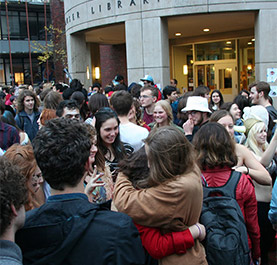
IRIS login | Reed College home Volume 96, No. 2: June 2017
Tags
"thesis"
Chem major battles malaria parasite
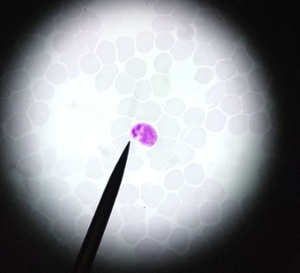
THE ADVERSARY. The malevolent malarial parasite plasmodium falciparum is responsible for killing more than 400,000 people every year. Most of the victims are children.
For her senior thesis, chemistry major Rose Gonoud ’17 squared off against one of humankind’s most ancient and implacable adversaries: Plasmodium falciparum, the parasite that causes malaria.
Plasmodium is a truly diabolical foe, responsible for the death of more than 400,000 people every year, according to the World Health Organization. It also has an extraordinary ability to mutate, developing resistance to many of the drugs currently used to fight it.
One technique for overcoming this resistance is to start with an old drug and fine-tune it to attack the newer strains of the parasite. Rose focused her research on decoquinate (DQ), a drug developed in the 1960s to combat bacterial infections in chickens. Last year, researchers made the surprising discovery that decoquinate is also effective against malaria, making it an attractive candidate for drug development. Unfortunately, there’s a problem. DQ is insoluble—it doesn’t dissolve in the bloodstream, making it impossible to deliver the drug to the organs where the parasite usually hangs out. Rose’s mission was to see if she could find a way to make the drug more soluble without sacrificing its malaria-killing power.
Continue reading Chem major battles malaria parasite
Tackle Climate Change—Go Birdwatching
Bald eagles. Great Blue Herons. Mallard ducklings.
Anyone who has taken a study break to walk the forested Reed Canyon trails looking for birds and wildlife knows that connecting with the natural environment creates a sense of belonging and stewardship. Getting city-dwellers into green spaces and urban forests is an effective way to create a culture of conservation. But environmental studies–history major Esther Forbyn ’16 found that some Portlanders, especially traditionally marginalized groups like low-income residents and recent immigrants, can feel excluded from these spaces. Not only are these members of the community missing out on the benefits of communing with nature, the conversation about solutions to environmental problems is lacking important voices.
Continue reading Tackle Climate Change—Go Birdwatching
Physics Major Invents New Musical Instrument
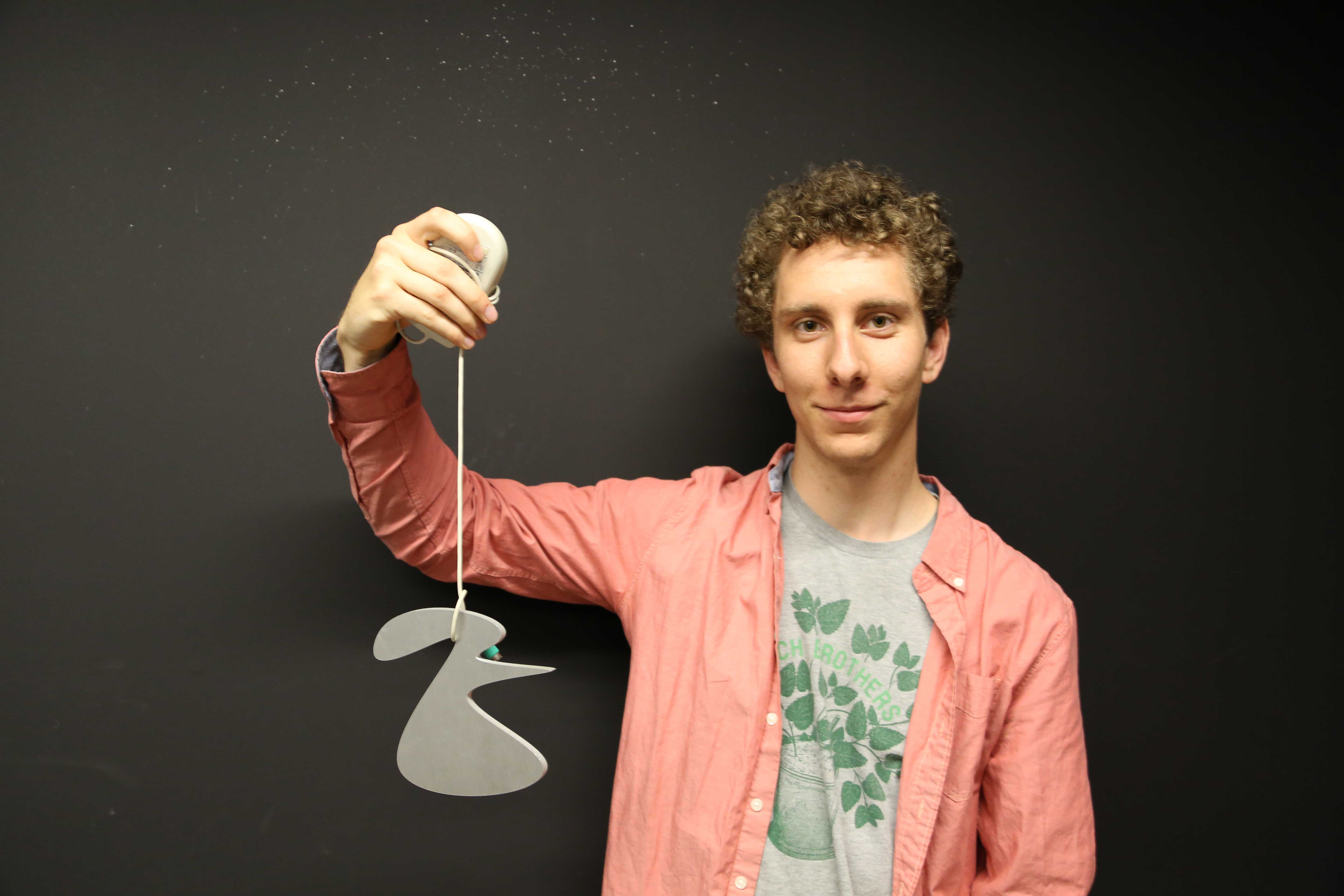
Evan Peairs ’16 invented a musical instrument for his physics thesis by borrowing ideas from aerospace and structural engineering. Photo by Chris Lydgate
Physics major Evan Peairs ’16 has built a new kind of bell for his senior thesis using an innovative design that is capable, in theory, of generating musical tones never previously achieved by a percussive instrument.
The instrument—which is related to a musical family known as the bell plate—consists of a slab of aluminum carved in an otherworldly shape that resembles a mutant unicorn. When you strike it with your finger, however, it rings with the sweet, reverent chime of a church bell.
Using the acoustical wizardry he developed for his thesis, Evan is now designing bell plates that sound like a gong, a xylophone, and a woodblock. “And I’m working on one that sounds like a trumpet,” he adds, showing a visitor around a laboratory in the Physics Building that bristles with lasers, mirrors, wires, pipes, and imposing electronic gadgetry.
Continue reading Physics Major Invents New Musical Instrument
Theatre Major Goes down the Rabbit Hole

Thesis production "Here, Now" by Marisa Kanai ’15 is an interactive performance with an "audience" of two. Here the enigmatic Rabbit offers tea to a member of the audience. Fiona Wiedermann
I’m standing in the middle of an old-fashioned living room, surrounded by empty suitcases, tea cups, overflowing bookshelves, and a Twister mat, attempting to communicate with a dapper rabbit brandishing a tennis racket.
This could only happen at Reed—to be precise, onstage at Here, Now, a remarkable thesis production by theatre major Marisa Kanai ’15, which is performed for only two audience members at a time.
Marisa is working with her faculty adviser, Prof. Peter Ksander [theatre 2011–], to explore immersive environments and interactivity in performance, inviting the audience to engage in an intimate relationship with the actors, the space, and the content of the event itself.
Continue reading Theatre Major Goes down the Rabbit Hole
How a Galaxy Evolves
Humankind’s view of the cosmos, however magnificent, is fundamentally static. Astrophysicists know that distant astronomical objects (stars, nebulae, galaxies) are in constant motion, but this is invisible to human eyes because it takes place on a timescale which is unimaginably vast. In fact, except for the moon, the planets, and the occasional comet, the night sky has looked essentially the same for the entire history of human civilization.
Recently astrophysicists have used computers to speed things up. For my thesis with Johnny Powell [physics 1987–], I wrote a computer program to simulate the evolution of a typical spiral galaxy. The central premise is that by calculating the gravitational forces acting on a relatively small number of stars, we can simulate the evolution of a real galaxy, which consists of hundreds of billions of stars.
Continue reading How a Galaxy Evolves
Chem Major Nabs Class of ’21 Award
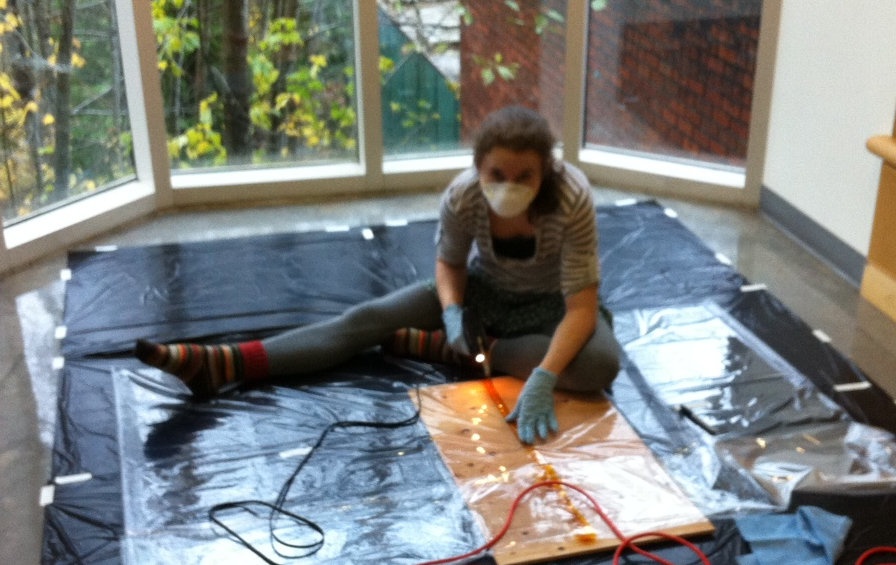 The effect of nitrogen dioxide on aerosol formation might not sound like a particularly creative field of study—unless you study chemistry at Reed.
The effect of nitrogen dioxide on aerosol formation might not sound like a particularly creative field of study—unless you study chemistry at Reed.
Chem major Danielle Draper ’13 just won the coveted Class of ’21 Award, recognizing exceptional creativity, initiative, and spontaneity, for her thesis, which looked at how nitrogen dioxide (NO2) emitted by vehicles affects the formation of aerosols, or tiny particles, in forests. It turns out that trees naturally emit gasses—like those responsible for the scent of spruce needles—that turn into aerosols in the atmosphere. Danielle wanted to know how that process was affected by manmade emissions--in other words, how humans are changing the “natural” flow of a forest. In particular, she investigated this reaction as it occured at night, under the cover of darkness.
To conduct her experiments, Danielle had to construct an atmospheric chamber, build a special computer model to study chemical kinetics, and analyze reams of data. Her findings were intriguing. While most tree emissions (e.g. the spruce-scent particles) react with NO2 to create more particles in the atmosphere than they would have alone, alpha-pinene, an emission largely found in pine trees, actually produced fewer particles when combined with NO2.
Continue reading Chem Major Nabs Class of ’21 Award
The Turning of the Thesis
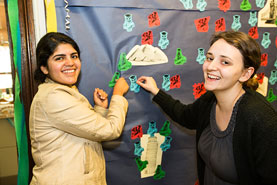
Making thesis deadline also entitles seniors to add their names to the thesis board outside the registrar's office. Photo by Eren Veziroglu ’16
Sociology major Brittany Wideman ’13 nudges the stack of paper across the counter and takes a deep breath. Her senior thesis, representing a year of intensive work (and two all-nighters over the past week), is now in the hands of the registrar’s office. More specifically, the hands of graduation specialist Mark Fowler, whose job it is to check over the final drafts of the theses to make sure that they conform to style guidelines: title page formatted properly, page numbers in the correct spot, adviser signature on the right line, etc.
Continue reading The Turning of the Thesis
Spring Fall Thesis Parade is a Soggy Success
Portland can be a bit gloomy this time of year, when unremitting rain provides the soundtrack for what can seem like unending final's work. But those grey skies couldn't dampen the spirit of the spring-fall thesis parade, which was celebrated last week in a particularly heartwarming bout of collective effervescence.
Bedecked in colorful costumes and covered in glitter, students danced and hugged each other to the beat of Reed’s drum corps. About 30 seniors hurled their thesis drafts on the bonfire in front of the library as classmates sprayed them with champagne (thankfully the temperature did not dip below the mid 50s).
Continue reading Spring Fall Thesis Parade is a Soggy Success


